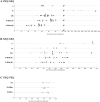BSE can propagate in sheep co-infected or pre-infected with scrapie
- PMID: 34099797
- PMCID: PMC8184847
- DOI: 10.1038/s41598-021-91397-8
BSE can propagate in sheep co-infected or pre-infected with scrapie
Abstract
To understand the possible role of mixed-prion infections in disease presentation, the current study reports the co-infection of sheep with bovine spongiform encephalopathy (BSE) and scrapie. The bovine BSE agent was inoculated subcutaneously into sheep with ARQ/ARQ or VRQ/ARQ PRNP genotypes either at the same time as subcutaneous challenge with scrapie, or three months later. In addition, VRQ/VRQ sheep naturally infected with scrapie after being born into a scrapie-affected flock were challenged subcutaneously with BSE at eight or twenty one months-of-age. Sheep were analysed by incubation period/attack rate, and western blot of brain tissue determined the presence of BSE or scrapie-like PrPSc. Serial protein misfolding cyclic amplification (sPMCA) that can detect very low levels of BSE in the presence of an excess of scrapie agent was also applied to brain and lymphoreticular tissue. For VRQ/ARQ sheep challenged with mixed infections, scrapie-like incubation periods were produced, and no BSE agent was detected. However, whilst ARQ/ARQ sheep developed disease with BSE-like incubation periods, some animals had a dominant scrapie western blot phenotype in brain, but BSE was detected in these sheep by sPMCA. In addition, VRQ/VRQ animals challenged with BSE after natural exposure to scrapie had scrapie-like incubation periods and dominant scrapie PrPSc in brain, but one sheep had BSE detectable by sPMCA in the brain. Overall, the study demonstrates for the first time that for scrapie/BSE mixed infections, VRQ/ARQ sheep with experimental scrapie did not propagate BSE but VRQ/VRQ sheep with natural scrapie could propagate low levels of BSE, and whilst BSE readily propagated in ARQ/ARQ sheep it was not always the dominant PrPSc strain in brain tissue. Indeed, for several animals, a dominant scrapie biochemical phenotype in brain did not preclude the presence of BSE prion.
Conflict of interest statement
The authors declare no competing interests.
Figures




Similar articles
-
Rapid and discriminatory diagnosis of scrapie and BSE in retro-pharyngeal lymph nodes of sheep.BMC Vet Res. 2006 Jun 9;2:19. doi: 10.1186/1746-6148-2-19. BMC Vet Res. 2006. PMID: 16764717 Free PMC article.
-
Immunohistochemical characteristics of disease-associated PrP are not altered by host genotype or route of inoculation following infection of sheep with bovine spongiform encephalopathy.J Gen Virol. 2005 Mar;86(Pt 3):839-848. doi: 10.1099/vir.0.80364-0. J Gen Virol. 2005. PMID: 15722547
-
Enhanced virulence of sheep-passaged bovine spongiform encephalopathy agent is revealed by decreased polymorphism barriers in prion protein conversion studies.J Virol. 2014 Mar;88(5):2903-12. doi: 10.1128/JVI.02446-13. Epub 2013 Dec 26. J Virol. 2014. PMID: 24371051 Free PMC article.
-
Scrapie and experimental BSE in sheep.Br Med Bull. 2003;66:171-83. doi: 10.1093/bmb/66.1.171. Br Med Bull. 2003. PMID: 14522858 Review.
-
Conventional and State-of-the-Art Detection Methods of Bovine Spongiform Encephalopathy (BSE).Int J Mol Sci. 2023 Apr 12;24(8):7135. doi: 10.3390/ijms24087135. Int J Mol Sci. 2023. PMID: 37108297 Free PMC article. Review.
References
Publication types
MeSH terms
Substances
Grants and funding
LinkOut - more resources
Full Text Sources
Research Materials

